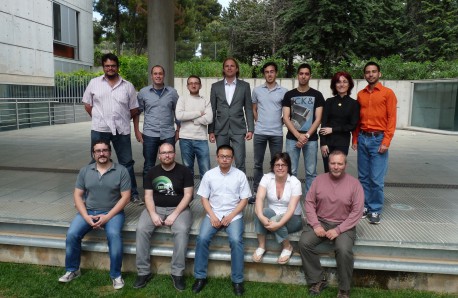López
Research group

Research abstract
The aim of the group is to employ atomistic simulations to understand the mechanisms that govern chemical processes in heterogeneous catalysis and materials that might be appealing due to their ability to extract, store or provide energy. Both the analysis of reaction networks, activity and selectivity issues and the final tests on the stability of the potential materials are fundamental to establish a solid background to determine the potentialities of catalyst candidates for a given chemical transformation. As for the new energy materials their performance and stability are two of the main goals in our research.
Our collaboration with several experimental groups is of fundamental importance to define and compare models that can later be applied to suggest experiments and new materials to be explored. To this end, the use of massive computational resources, as those provided by the RES-BSC is required. We are thankful to them for these resources that help in placing us as players at the European level.
Topics addressed
- Atomistic simulations of chemical processes in heterogeneous catalysis
- Understanding new energy materials’ performance and stability
Articles
“HCl oxidation on IrO2-based catalysts: from fundamentals to scale up”
ACS Catal. (2013) 3, 2813 − 2822
M. Moser, C. Mondelli, A. P. Amrute, A. Tazawa, D. Teschner , M. E. Schuster, A. Klein-Hoffman , N. López, T. Schmidt, J. Pérez-Ramírez
“Promoted Ceria: A Structural, Catalytic, and Computational Study”
R. Farra, M. García-Melchor, M. Eichelbaum, M. Hashagen, W. Frandsen, J. Allan, F. Girgsdies, L. Szentmiklósi, N. López, D. Teschner
ACS Catal. (2013) 3, 2256 − 2268
“Understanding CeO2 as a Deacon catalyst by probe molecule adsorption and in situ infrared characterisations”
Phys. Chem. Chem. Phys. (2013) 15, 3454 − 3465
R. Farra, S. Wrabetz, M. E. Schuster, E. Stotz, N. G. Hamilton, A. P. Amrute, J. Pérez-Ramírez, N. López, D. Teschner
“Interaction mechanisms of ammonia and Tin oxide: A combined analysis using single nanowire devices and DFT calculations”
J. Phys. Chem. C. (2013) 117, 3520 − 3526
F. Shao, M. W. G. Hoffmann, J. D. Prades, J. R. Morante, N. López, F. Hernández-Ramírez
“Scanning Tunneling Microscopy and molecular dynamics study of the Li2TiO3(001) surface”
J. Phys. Chem. C (2013) 117, 5126 − 5131
K. Azuma, C. Dover, D. C. Grinter, R. Grau-Crespo, N. Almora-Barrios, G. Thornton, T. Oda, S. Tanaka
“On the properties of binary rutile MO2 compounds, M = Ir, Ru, Sn, and Ti: A DFT study”
J. Chem. Phys. (2013) 138, 194706
G. Novell-Leruth, G. Carchini, N. López
“Au@Ag Nanoparticles: Halides Stabilize {100} Facets”
J. Phys. Chem. Lett. (2013) 4, 2209 − 2216
S. Gómez-Graña, B. Goris,T. Altantzis, C. Fernández-López, E. Carbó-Argibay, A. Guerrero-Martínez, N. Almora-Barrios, N. López, l. Pastoriza-Santos, J. Pérez-Juste, S. Bals, G. Van Tendeloo, L. M. Liz-Marzán
“How theoretical simulations can address the structure and activity of nanoparticles”
Top. Catal. (2013) 56,1262 − 1272
G. Carchini, N. Almora-Barrios, G. Revilla-Lopez, L. Bellarosa, R. García-Muelas, M. Garcia-Melchor, S. Pogodin, P. Błoński, N. López
“Adsorbate-Induced Oxygen Vacancy Mobility in Ultra-Thin Oxide”
J. Phys. Chem. C (2013) 117, 23806 – 23811
L. Bellarosa, N. Lopez, K. Honkala
“Silver Nanoparticles for Olefin Production: New Insights into the Mechanistic Description of Propyne Hydrogenation”
ChemCatChem (2013) 5, 3750 – 3759
G. Vilè, D. Baudouin, I. N. Remediakis, C. Copéret, N. López, J. Pérez-Ramírez